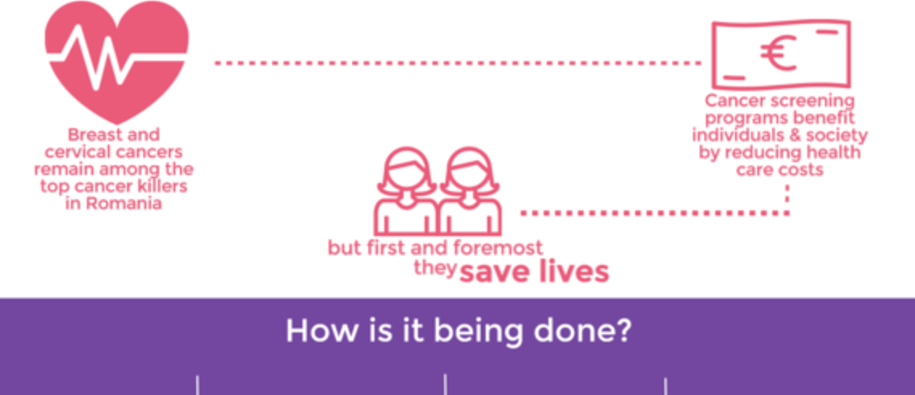Cancer mortality rates in Romania are above the EU average and despite being largely amenable, cervical and breast cancer remain as the most common fatal cancers. One of the underlying factors is a lack of systematic screening programmes as defined by current public health guidelines. Despite the increase in screening programmes in the last years, the success of the measures is still limited:
“Without a proper coverage of the population at risk, prevention activities have not had an effective impact on cervical cancer mortality rates,” explains Dr. Nicula Florian, Principal Investigator of the CEDICROM project at the Ion Chiricuţă Institute for Oncology (IOCN).
The Institute has been a pioneer in cancer prevention in Romania. Through the centre’s pilot regional cervical cancer screening programme – the first of its kind in Romania – 50% of women between the ages of 25 and 64 in Cluj County have now undergone pap tests, which is the standard test used to detect potentially pre-cancerous and cancerous processes in the cervix.
However, the coverage has been lower in rural areas. This difference can be explained by multiple factors. Women in these areas often face Information barriers and have limited means of transportation for visiting health centres, which are usually located far away from their homes. The team realised that in order to reach those women, a different approach was needed.
Through the CEDICROM project, the team aims to be able to increase the efficiency of the current cancer screening programme by reaching out to these women, inform them about the risks of cancer and offer them free screening:
“We aim to perform as much as 10 000 pap tests to at least 2 500 Roma women at risk in suburban Cluj-Napoca, the Huedin area, and in rural communities in Cluj county, but likewise in Arad, Calarasi, Gorj and Ialomita counties. Isolated villages and villages where family doctors do not ensure women’s access to national screening programme are also in focus,” explains Dr. Florian.
Roma women are not the only minority group benefiting from the project. Other isolated ethnic groups are also being targeted, including Slovak and Russian women in Tulcea and Maramues counties.
Saving lives
The project has already started delivering results – 30 people have been trained to manage cancer screening programs and the project’s mobile unit has made over 40 visits to Roma and other isolated communities to conduct screening and provide information:
“Up to date, we have tested 1 813 women, with 1 186 results delivered and 42 dysplasia’s precursory cancer lesions referred to treatment,” says Dr. Florian. Dysplasia is the medical term for abnormal cells on the cervix caused by the HPV virus. If the abnormalities are mild and few in number, they usually go away without treatment. However, some cases of moderate dysplasia, and most cases of severe dysplasia, will not go away on their own. At this stage, the cells are considered "pre-cancer". In other words, if they are not found and treated, they could develop into cervical cancer. This is why these tests have proved so important:
“The treatment of these lesions represents the main benefit of the project – saving the lives of women, who generally are young and active in both family and society,” explains Dr. Florian.
Countering breast cancer
In addition to cervical cancer screening, the project also includes a feasibility study on the first regional pilot programme on breast cancer screening in Romania. The pilot programme will test 5 000 women in Cluj county.
With 1 862 women tested so far, the pilot programme has already saved lives. Ten percent of the women tested were called in again for further evaluation. These were followed by several biopsies, with the first seven cases positive for malignancy. Locating the lesions in early stages while they’re still small and curable has proven crucial:
“In the absence of the project, these lesions would probably have been able to evolve without symptoms to advanced stages, resulting in both reduced chances for treatment and reduced quality of life,” notes Dr. Florian.
Furthermore, the feasibility study will provide important insights for Romanian health authorities, particularly when it comes to transforming health screening programmes from regional pilots to national strategies.
Extensive cooperation
The project is conducted in close cooperation with the Cancer Registry of Norway which operates the Norwegian national screening programmes for both cervical and breast cancer. The Romanian team members visited Norway Cancer Registry in Oslo, as well as the breast cancer unit in Drammen where a specific training course for the Romanian team is to be organised.
The cooperation is not only limited to the CEDICROM project –a joint project is likewise underway with support from the Romanian ‘Research programme’. Through the project, the two organisations work together to understand the access barriers to cervical cancer screening of Roma and other disadvantaged groups:
“We use participant observation, interviews and focus group interviews for Roma women, for women from rural areas, as well as focus groups of key informants from IOCN and for decision makers in Bucharest. This gives us broad knowledge of the screening program and organization of health services in Romania,” explains Trude Andreassen, a PhD student at the Cancer Registry of Norway who participates in the project.
Read more about the Romanian ‘Public Health Initiatives’ programme

